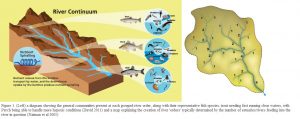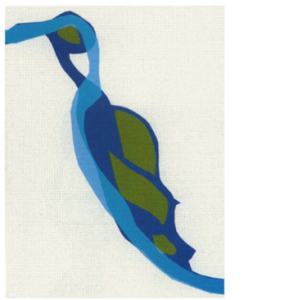With a growing global population, dams are more relied on than ever to provide electricity and secure land; with over 45,000 >15m tall dams existing globally (World Commision.2005), and mans’ intrusion on biodiversity being a well-known threat (MEA, 2005a), dams may not be as environmentally friendly as they seem.
Dams ultimately obstruct water ways, breaking up continuous systems and causing a number of effects due to their construction (Collier 1996). Like sticking tape across guitar strings; it will still play music, but not to the same extent. They do so in 4 main ways(Ligon 1995):
- Water flow
- Sediment
- Nutrients
- Energy
- Biota
Water flow is slower upstream due to the build-up of water, which can lead to the creation of reservoirs, an entirely new Ecosystem. The rivers, are more likely to host large plant populations and a different community of organisms (typical of higher order rivers), at much lower orders (Figure.1).
Downstream flow is regulated by the dam itself, and so changes on location. But typically reduce peak flows that provide erosion and creation of sediment downstream (McCartney 2009).

Dams are nutrient and sediment sinks, inhibiting what’s carried downstream. Reducing the flow of all particles to downstream systems, and increasing their build-up in upstream systems, causes different shifts in their Ecosystems. High nutrients upstream puts systems at risk of Eutrophication (a swift increase in phytoplankton blocking sunlight to larger plants, causing substantial loss of oxygen and life), but the loss of material downstream can cause other changes (Figure.2).

Energy includes temperature. Larger reservoirs can become stratified, making specific levels: An upper, warmer, oxygen rich layer and a lower, colder, high nutrient and low-oxygen layer. Dam outflow can come from either of these levels, which effects what occurs downstream. Any change in temperature often puts areas at odds with what it should be for seasonal levels, such as reducing fish growth and plant productivity if lowered (McCartney 2009).
With Biota, fish community migration is the main issue. This mainly refers to the reproduction cycles of migratory fish, such as salmonids, which reproduce in highland areas after migrating upstream. Many dams introduce fish ‘ladders’ in which the fish can ‘jump’ upstream, and others such as the ‘fish cannon’ (see video) or bristle walkways for hagfish. However the main problem is fish can’t typically find the entrance.
Freshwater Ecosystems are more diverse per m2 than both land and marine biomes (MEA 2005b), to sustain this diversity, regional change across the entire river system needs to be present (MEA 2005a). Heavily dammed rivers (e.g. 25), such as the Snake and Columbia Rivers, USA, have ecosystems vastly different from unmodified rivers, causing the loss of its Sockeye and Chinook Salmon (Collier et al 1996). This also causes a similarity of conditions, which increases the risk of invasive species, as they can compete better in ‘more general’ ecosystems (Olden, 2006).
Overall Dams vastly impact river ecosystems, a brief few have been highlighted, but needless to say there are many more, they’re not so ‘friendly’ after all.
.
References
Word Count: 499
Collier, M., Webb, R.H. & Schmidt, J.C. (1996) Dams and Rivers: A Primer on the Downstream Effects of Dams
[David] (06, February, 2011) River Continum, Retrieved from URL: http://yorkshiredalesriverstrust.blogspot.co.uk/2011/02/ecology-of-river-changes-as-you-move.html
Ligon, F.K., Dietrich, W.E. & Trush, W.J. (1995) Downstream Ecological Effects of Dams, BioScience, 45(3): 183-192
McCartney, M. (2009) Living with Dams: Managing the Environmental Impacts, Water Policy, 11(1): 121-139
Millenium Ecosystem Assessment (2005a) Ecosystems and Human Well-being: Biodiversity Synthesis, World Resource Institute, Washington, DC
Millenium Ecosystem Assessment (2005b) Ecosystems and Human Well-being: Wetlands and Water Synthesis, World Resource Institute, Washington, DC
Naiman, R.J., Decamps, H. & McClain, H.E. (2005) Riparia: Ecology, Conservation, and Management of Streamside Communities, Elseiver, New York
Olden, J.D., LeRoy Poff, N. & Bestgen, K.R. (2006) Life-History Strategies Predict Fish Invasions and Extirpations in the Colorado River Basin, Ecological Monographs: Ecological Society of America, 76(1): 25-40
[Tech Insider] (2017, 3rd Feburary) Salmon cannon gives fish a boost over dams, Retrieved from: https://www.youtube.com/watch?v=xIB2616zcLk
World Commissions on Dams (2000) Dams and Development: A New Framework for Decision-Making, Earthscan Publications, London
Recent Comments